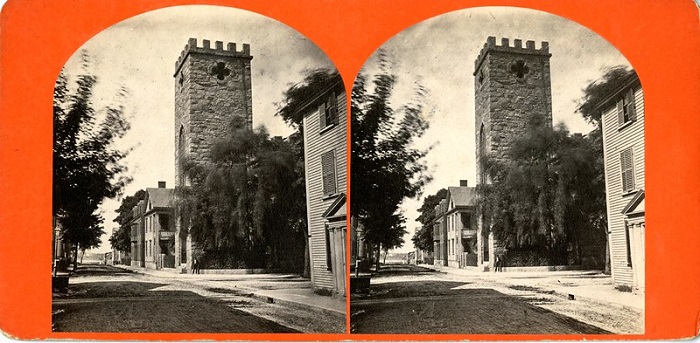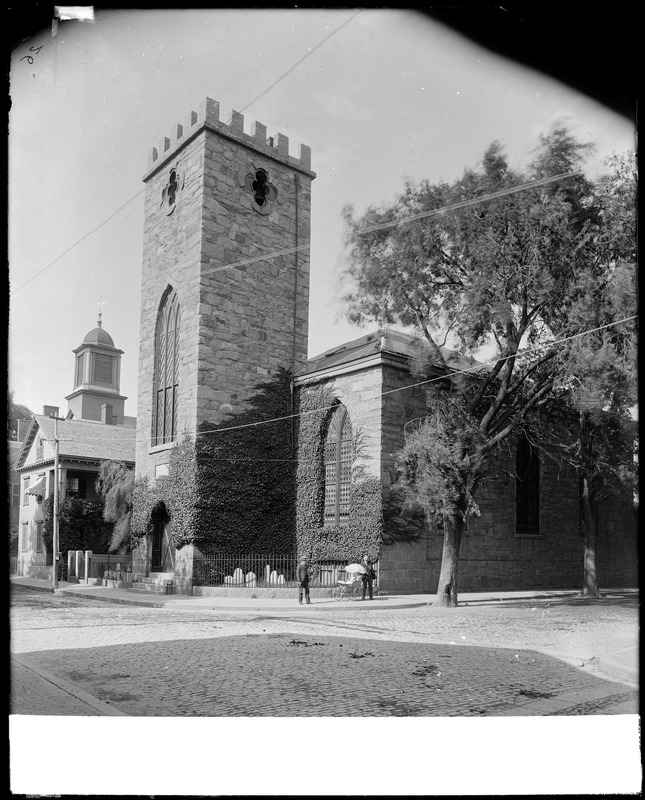St. Peter’s Episcopal Church is a historic church in Salem and was the first Anglican church in the city. It is built on land donated in 1733 by local merchant Philip English, who had been accused of witchcraft during the Salem Witch Trials but avoided trial by temporarily fleeing Salem.
Built in 1833-34, the church is a one-story Gothic Revival-style stone building with a square bell tower and was designed by architect Isaiah Rogers.
The tower has one large arched window and there are also two large arched windows on the ground floor on either side of the entrance.
The church also features a one-story stone chapel with a gable roof at the rear of the church, which was constructed in 1871, and a two-story brick building built next door to the church in 1936 that serves as a rectory. A small cemetery is located at the front of the church with an iron fence around it.
The church is the second church that has existed on this spot. The first was a small wooden church built in 1734.
According to an article later published in the Salem Observer in 1833, the church was enlarged sometime around 1763 or 1773 when 20 feet was added to the length of the church in the back.
Since many of the parishioners were loyalists, they were often harassed by locals during the early days of the American Revolution. Patriots would often gather on the upper balcony inside the church and spit on the parishioners below (SAL. 2422, 17).
In 1775, the church was closed down after the Massachusetts General Court ordered all churches of the Church of England to be closed. It reopened only after the American Revolution ended.
In 1833, due to the age of the old wooden church and the growing congregation, the church was demolished and the present stone church was built in its place using granite sourced in nearby Rockport, Mass.
Since the new church was much larger than the old one, some of the graves in the cemetery at the back of the church had to be relocated, according to an article in the Salem Observer on June 8, 1833:
“In digging the foundation of the new Episcopal Church in this town remains of the many old worshippers of St. Peter’s were disturbed — Among them, was the remains of Jonathan Pue, Esq., ‘His Majesty’s Inspector and Informer,’ who died in the year 1760, seventy-three years since. His wig was in a good state of preservation and his worsted sash was not entirely decayed; three silver buttons were also found in his grave. ”
The article also reported that a brick tomb or grave was discovered under the area of the church that had been expanded around 1763 and it was rumored to be the grave of Philip English:
“Sixty or seventy years ago about 20 feet was added to the length of the church, and directly under that part a brick grave was found, built in a very substantial and workmanlike manner, plastered and with a wall 8 inches thick. Nothing was found by which a discovery could be made who the occupant was. It had been thought by some it might be Phillip English — it is certain it was a person of some note, as six silver plated coffin handles were found in the grave, and some fragments of an ornamented plate; the bones were quite large, and must have belonged to a large man.”
The headstones of the disturbed graves were relocated to the small grassy area in the front of the building but the bodies still remain under the church.
In 1845, an addition designed by Richard Upjohn was constructed at the rear of the church in which a High Victorian chancel (the space around the altar) was added.
In 1871, the chapel was constructed at the rear of the building. It measured about 20 by 60 feet in size and was connected to the main building with a large arch. The new chapel also featured an organ room in which a new organ was placed.
Since the chapel was built directly over the old cemetery in the back, some of the headstones were moved to the grassy area in the front of the building while others were placed inside the chapel walls to preserve them.
In 1892, a building next door to the church was donated to the church by James B. Curwen for use as a parish. After the Great Salem Fire of 1914 broke out, the building served as a temporary hospital.
In 1937, the parish building was razed and the current parish house was constructed in its place, which was officially dedicated on February 5, 1937, and was designed to look like a traditional English Parish building.
In January of 2018, a series of three snowstorms created an ice dam on the roof of the church which destroyed the roof and damaged the mechanism that rings the church’s bells. The church closed until April of that year while a new roof and ceiling were constructed. The total cost of the damage was $750,000.
In July of 2018, several granite slabs that trim the edge of the chapel’s gabled roof slid off the roof on to the pavement below. The incident happened overnight when the sidewalk was empty so there were no injuries reported.
St. Peter’s Church Burying Ground:
St. Peter’s Church Burying Ground is located at the front of St. Peter’s Church, on both sides of the entrance to the church. The cemetery is less than one acre in size and is surrounded by an iron fence.
The section to the left of the church tower has three rows of markers, each containing eight to 10 stones. These headstones are mostly from the 18th and 19th century and are primarily made of slate. There are also several broken headstones and an obelisk monument.
The section to the right of the church tower has two rows of markers. The back row has eight headstones and the front row has five and the headstones are a mix of slate and marble.
The cemetery used to be located at the back of the property and once contained 50 graves but the headstones were relocated to the front of the building when the church was rebuilt in 1833 and expanded in 1871. The last burials took place in the cemetery in 1860.
Sources:
“Saint Peter’s Episcopal Church Historical Marker.” The Historical Marker Database, hmdb.org/m.asp?m=47989
Diamantides, Alyse. “Bringing back the bells.” The Salem News, 27 Aug. 2019, salemnews.com/news/local_news/bringing-back-the-bells/article_2724d13c-5fbe-5ceb-a774-d634e9647c5f.html
“Cement blocks fall from roof of historic Salem church.” Boston 25 News, 17 July. 2018, boston25news.com/news/cement-blocks-fall-from-roof-of-historic-salem-church/791738861/
“Salem Observer.” Hawthorne in Salem, hawthorneinsalem.org/Literature/customhousesketch/auxfiles/deathtext.shtml
“SAL. 2422 Saint Peter’s Epsicopal Church and Rectory.” MACRIS, Massachusetts Cultural Resource Information System, mhc-macris.net/#!/details?mhcid=SAL.2422
“SAL. 3881 Saint Peter’s Episcopal Church Parish House.” MACRIS, Massachusetts Cultural Resource Information System, mhc-macris.net/#!/details?mhcid=SAL.3881
“SAL. 808 Saint Peter’s Church Burying Ground.” MACRIS, Massachusetts Cultural Resource Information System, mhc-macris.net/#!/details?mhcid=SAL.808


